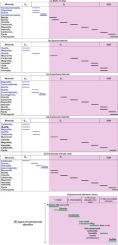当前位置:
X-MOL 学术
›
Ore Geol. Rev.
›
论文详情
Our official English website, www.x-mol.net, welcomes your feedback! (Note: you will need to create a separate account there.)
Structural And Hydrothermal Evolution Of The Shear-Zone-Related Iron-Oxide Enrichment In Metavolcano-Sedimentary Rocks Of The Intracontinental Araçuaí Orogen: The Case Of The Espírito Santo Iron Deposit
Ore Geology Reviews ( IF 3.3 ) Pub Date : 2020-09-01 , DOI: 10.1016/j.oregeorev.2020.103719 M.S. Santos , S.C.P. Cruz , L.M. Lobato , P. Mandetta , C.M. Burgos
Ore Geology Reviews ( IF 3.3 ) Pub Date : 2020-09-01 , DOI: 10.1016/j.oregeorev.2020.103719 M.S. Santos , S.C.P. Cruz , L.M. Lobato , P. Mandetta , C.M. Burgos

|
Abstract The Rio Sao Joao metavolcano-sedimentary sequence is located in the eastern border of the northern Espinhaco fold thrust belt, in the intracontinental Aracuai-West Congo Orogen. Mafic schist, quartz-, amphibole- and carbonate itabirites, as well as a carbonate-silicate rock, occur in the study area. These contain mineral assemblages compatible with the amphibolite-facies metamorphic conditions. Magnetite- and hematite-rich itabirites form a series of iron deposits in the region near Igapora-Caetite, Bahia state, Brazil. The Espirito Santo iron deposit has compact hematite layers truncating quartz itabirite with magnetite varying from 10 to 55 vol % of the rock volume; siliciclastic and mafic rocks also host iron-rich domains, variably enriched in magnetite and hematite. The deposit is hosted in compressional duplexes with structural top towards the SW. These structures have an Sn-1 // Sn foliation represented by compositional banding and parallel schistosity that is observed at all scales. Other common features are S/C/C, boudins, pinch-and-swell structures, as well as sheath, syn-tectonic folds, and a mineral stretching lineation (Lxn). Hydrothermal alteration was contemporaneous to the development of duplex and the Sn-1//Sn foliation. A distal alteration zone is dominated by a potassic (muscovite and-or biotite) ± chlorite assemblage and the intermediate zone by carbonate development. The proximal alteration zone constitutes the iron oxide (magnetite and hematite) domains; sulfide minerals as well as quartz veins (silicification) in association with other phases also formed. Hydrothermal magnetite is associated with C’ structures, which grows either including silicates and skeletal carbonates, or forming corrosion borders in these minerals. Lamellar hematite forms polycrystalline aggregates, characterizing the S/C structure in the Sn-1//Sn foliation, as well as the axial planar foliation (Sn) in intrafolial folds and the mineral stretching line Lxn. Data obtained by the LA-ICPMS technique show that, in general, in quartz-rich and amphibole itabirites hydrothermal magnetite is richer in REE than an early-stage magnetite. Hydrothermal magnetite REE pattern is close to that of the country rock of the mineralization. The formation of hematite- and magnetite-rich domains is related to the percolation of hydrothermal fluids that leached all components of the original silicates, quartz and the carbonates of all host rocks, and precipitated new hydrothermal phases taking advantage of the Ediacaran shear structures.
中文翻译:

大陆内阿拉苏伊造山带变质火山沉积岩中与剪切带相关的氧化铁富集的结构和热液演化:以圣埃斯皮里托铁矿床为例
摘要 Rio Sao Joao 变质火山-沉积层序位于Espinhaco 褶皱逆冲带北部东部边界,Aracuai-West刚果造山带。研究区有镁铁质片岩、石英、角闪石和碳酸盐斜长岩,以及碳酸盐-硅酸盐岩。这些包含与角闪岩相变质条件相容的矿物组合。在巴西巴伊亚州 Igapora-Caetite 附近的地区,富含磁铁矿和赤铁矿的 itabirites 形成了一系列铁矿床。Espirito Santo 铁矿床具有致密的赤铁矿层,截断石英斜纹石和磁铁矿,占岩石体积的 10 至 55 vol%;硅质碎屑岩和镁铁质岩也含有富铁的区域,不同程度地富含磁铁矿和赤铁矿。矿床位于压缩双相中,结构顶部朝向西南。这些结构具有 Sn-1 // Sn 叶理,由在所有尺度上观察到的成分带和平行片理表示。其他常见特征是 S/C/C、boudins、捏胀结构,以及鞘、同构造褶皱和矿物拉伸线 (Lxn)。热液蚀变与双相和 Sn-1//Sn 叶理的发展同时发生。远端蚀变带以钾质(白云母和-或黑云母)±绿泥石组合为主,中间带以碳酸盐岩发育为主。近端蚀变带构成氧化铁(磁铁矿和赤铁矿)域;硫化物矿物以及与其他相结合的石英脉(硅化)也形成。热液磁铁矿与 C' 结构有关,C' 结构包含硅酸盐和骨架碳酸盐,或在这些矿物中形成腐蚀边界。层状赤铁矿形成多晶聚集体,表征 Sn-1//Sn 叶理中的 S/C 结构,以及叶内褶皱和矿物拉伸线 Lxn 中的轴向平面叶理 (Sn)。通过 LA-ICPMS 技术获得的数据表明,一般而言,在富含石英和角闪石斜长石矿中,热液磁铁矿比早期磁铁矿富含 REE。热液磁铁矿稀土元素格局与矿化围岩相近。富含赤铁矿和磁铁矿域的形成与热液的渗透有关,这些热液浸出所有主岩的原始硅酸盐、石英和碳酸盐的所有成分,
更新日期:2020-09-01
中文翻译:

大陆内阿拉苏伊造山带变质火山沉积岩中与剪切带相关的氧化铁富集的结构和热液演化:以圣埃斯皮里托铁矿床为例
摘要 Rio Sao Joao 变质火山-沉积层序位于Espinhaco 褶皱逆冲带北部东部边界,Aracuai-West刚果造山带。研究区有镁铁质片岩、石英、角闪石和碳酸盐斜长岩,以及碳酸盐-硅酸盐岩。这些包含与角闪岩相变质条件相容的矿物组合。在巴西巴伊亚州 Igapora-Caetite 附近的地区,富含磁铁矿和赤铁矿的 itabirites 形成了一系列铁矿床。Espirito Santo 铁矿床具有致密的赤铁矿层,截断石英斜纹石和磁铁矿,占岩石体积的 10 至 55 vol%;硅质碎屑岩和镁铁质岩也含有富铁的区域,不同程度地富含磁铁矿和赤铁矿。矿床位于压缩双相中,结构顶部朝向西南。这些结构具有 Sn-1 // Sn 叶理,由在所有尺度上观察到的成分带和平行片理表示。其他常见特征是 S/C/C、boudins、捏胀结构,以及鞘、同构造褶皱和矿物拉伸线 (Lxn)。热液蚀变与双相和 Sn-1//Sn 叶理的发展同时发生。远端蚀变带以钾质(白云母和-或黑云母)±绿泥石组合为主,中间带以碳酸盐岩发育为主。近端蚀变带构成氧化铁(磁铁矿和赤铁矿)域;硫化物矿物以及与其他相结合的石英脉(硅化)也形成。热液磁铁矿与 C' 结构有关,C' 结构包含硅酸盐和骨架碳酸盐,或在这些矿物中形成腐蚀边界。层状赤铁矿形成多晶聚集体,表征 Sn-1//Sn 叶理中的 S/C 结构,以及叶内褶皱和矿物拉伸线 Lxn 中的轴向平面叶理 (Sn)。通过 LA-ICPMS 技术获得的数据表明,一般而言,在富含石英和角闪石斜长石矿中,热液磁铁矿比早期磁铁矿富含 REE。热液磁铁矿稀土元素格局与矿化围岩相近。富含赤铁矿和磁铁矿域的形成与热液的渗透有关,这些热液浸出所有主岩的原始硅酸盐、石英和碳酸盐的所有成分,



























 京公网安备 11010802027423号
京公网安备 11010802027423号